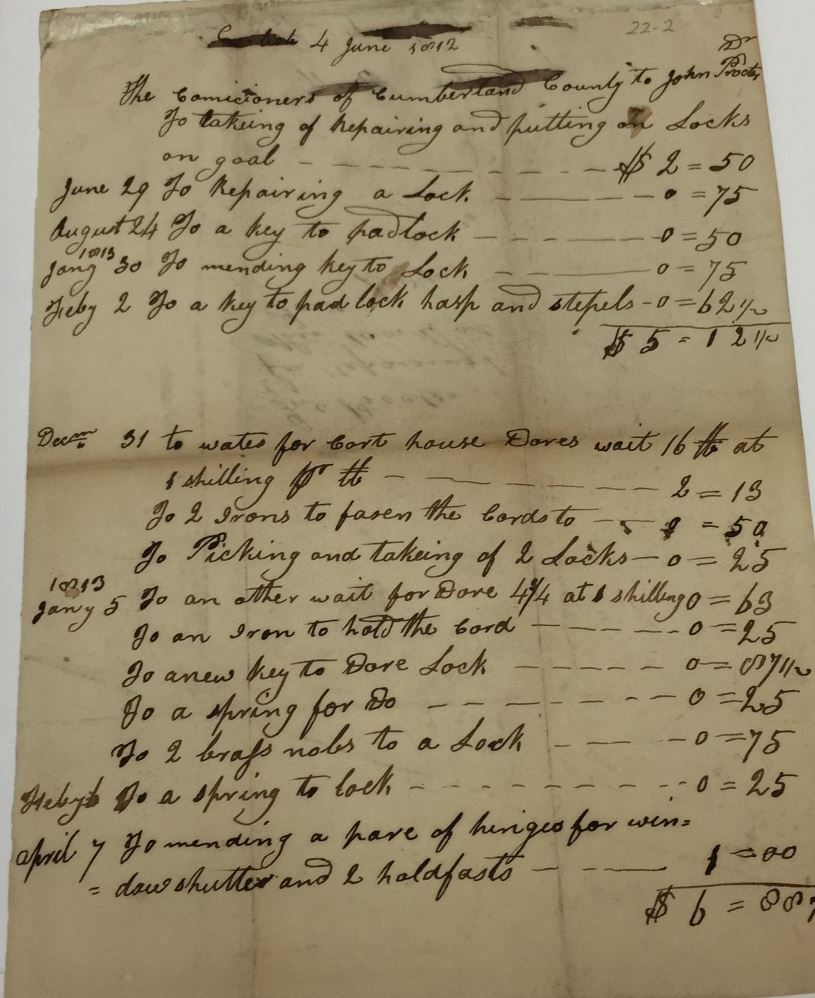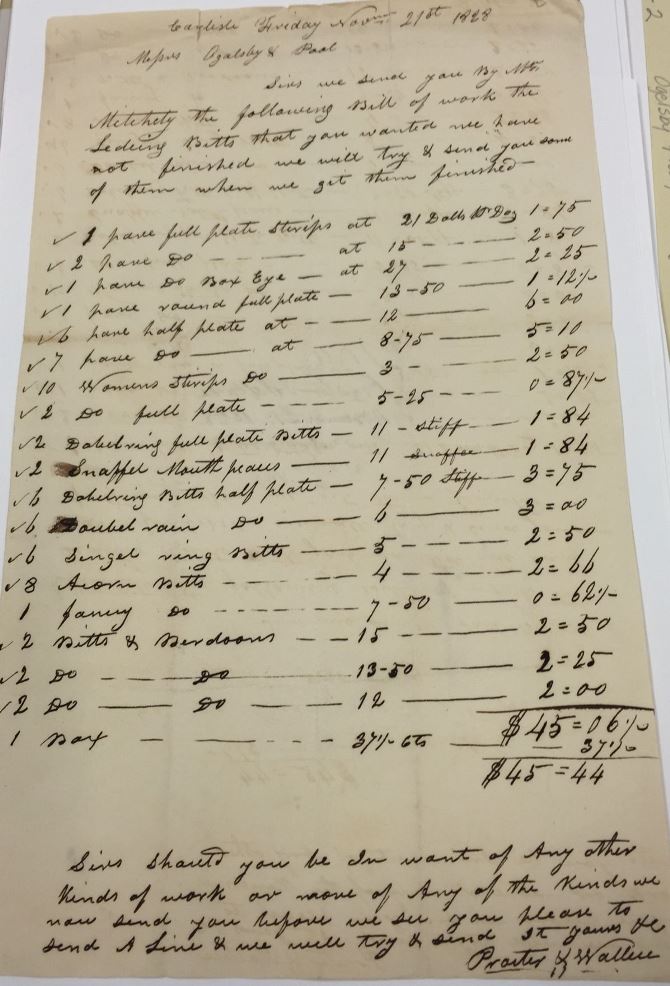German Bakers of Carlisle
The 1861 “List of Retailers” in Carlisle included five bakers. At least three of them were German immigrants who had settled in Carlisle in the 1830s and 1840s; John Sellers, John Schmohl and George Grossman.


Top: Proctor’s list of charges for work done for the county buildings in 1812 and 1813 and submitted to the County Commissioners for payment. Cumberland County Historical Society. Records of Oglesby and Pool, Ms 22-2.
Bottom: Proctor and Wallace’s 1828 bill to Harrisburg hardware merchants Oglesby and Pool.
“John Proctor was a well-known figure in the industrial world of Carlisle in the early days; he made bits when they were made and filed and plated by hand, silver money being melted to get material for the plating.”1
Proctor was working in Carlisle as early as 1812 according to a bill he submitted to the County Commissioners for work done at the jail and the court house. The work included making locks, keys, and hinges for window shutters.2
In January 1813, Proctor purchased Lot #239 on the corner of Louther and Bedford streets.3 It ran 240’ along Bedford Street and 60’ on Louther Street. There were several houses on the property, and sometime between 1826 and 1829 Proctor erected a brick shop. The 1832 Triennial Assessors Duplicate lists John Proctor, whitesmith and silver plater, with 200 feet of a lot on Louther and Bedford Streets with a stone house, a log house, smith and plating shop, etc. In 1835, John Proctor, whitesmith and plater, was taxed for 2/3 lot on Louther and Bedford streets including one stone and one brick house, a brick smith shop, a frame factory and also a frame stable and log house.
Several dozen letters in the 1820s between Proctor and Harrisburg hardware merchants Ogelsby and Pool provide an insight into Proctor’s business.4 Proctor took on a partner, and from 1827 through 1831 letters to Oglesby and Pool were signed “Proctor and Wallace.” The 1832 tax list for Carlisle records a George Walls, whitesmith. He may be the same George Wahls who filed for insolvency in 1832,5 and may have been the Wallace of Proctor and Wallace.
The names of several of Proctor’s employees are known because they declared insolvency. In 1831, George Prysock (Prysough) filed for insolvency stating that he “is by occupation a filer at the factory of Messrs Proctor & Wallace, & whilst working there he contracted debts…and is not at this time able to pay the same on account of his not having work…”6 In 1833, when he declared insolvency again, he was still a filer “in the employ of Mr. John Proctor in Carlisle.” He said that “he has a wife and one child to support, and sickness of himself and family is the reason of his not being able to pay his just debts…”7
Samuel Mathews filed for insolvency in 1834. “Petitioner (who is a colored man)” he wrote, “has a wife and two small children to support. That he is lame in the right foot. That he is working with Mr. Proctor at this time as a filer at $10.00 per month. That on account of losing time, the support of himself and family, his lameness etc., prevents him from paying his just debts.”8
John Roth (Rath), a whitesmith, filed for insolvency in 1833. He stated that he “has a wife and four children to support. That the wages which he receives is not sufficient to enable him at this time to support his family and pay the amount of debts against him. That during the year 1832 he had a great deal of sickness in his family occasioned by varioloid9 by which he lost much time.” He transferred all his real and personal estate required by law to John Proctor, one of his creditors.10
Proctor was sued at the 1845 August Term of Court for a $475 debt he owed to Roger Clark. The sheriff levied Proctor’s goods including: “lot of carpet, chairs, rocking chair, settees, looking glasses, tables, mantle clock, small stove, three bureaus, two saddles, book case, case of drawers, three boxes of plated stirrups and bridle bits, lot of locust posts, sleigh, forks, rakes, etc. and sold them.” The sale of the goods totaled $207.18 Also levied was a “lot of ground situate on the north east corner of Louther and Bedford Streets in Carlisle 60 x 200 feet on Lot #239 having thereon erected a two story stone house, a two story log house, blacksmith shop, several frame shops, a frame stable and a well in the yard,” and two lots of ground in Carlisle containing 1 ½ acres each bounded by Sterrett’s Gap Road on the east.11
John Proctor died on January 10, 1847. He had married Mary H. Officer, the daughter of Carlisle cabinetmaker John Officer, on October 17, 1815.12 Mary Proctor died in 1882. They are both buried in Carlisle’s Old Graveyard.
The 1861 “List of Retailers” in Carlisle included five bakers. At least three of them were German immigrants who had settled in Carlisle in the 1830s and 1840s; John Sellers, John Schmohl and George Grossman.
[1] Biographical Annals of Cumberland County, Pennsylvania: Containing biographical sketches of prominent and representative citizens and of many of the early settled families. (Chicago: Genealogical Pub. Co., 1905), 179. (Biography of John Spahr who worked for Proctor).
[2] Cumberland County Historical Society. Records of Oglesby and Pool, Ms 22-2.
[3] Cumberland County Recorder of Deeds. Deed Book 1-AA-312.
[4] Cumberland County Historical Society. Records of Oglesby and Pool , Ms 22-2.
[5] Cumberland County Prothonotary, Insolvent Debtor Petitions: 1832.1215. http://records.ccpa.net/weblink_public_print/DocView.aspx?id=314169&dbid=7
[6] Cumberland County Prothonotary, Insolvent Debtor Petitions: 1831.1093. http://records.ccpa.net/weblink_public_print/DocView.aspx?id=309960&dbid=7
[7] Cumberland County Prothonotary, Insolvent Debtors Petitions: 1833.1312. http://records.ccpa.net/weblink_public_print/DocView.aspx?id=320434&dbid=7
[8] Cumberland County Prothonotary, Insolvent Debtors Petitions: 1834.1395.
[9] A mild form of small pox.
[10] Cumberland County Prothonotary, Insolvent Debtors Petitions: 1833.1313.
[11] Cumberland County Clerk of Courts, Civil Case Papers: No. 27 August Term 1845. Cumberland County Archives, Carlisle, PA.
[12] Rev. Henry R. Wilson. Silver Spring Presbyterian Church records.